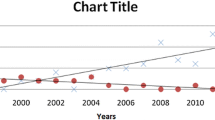Abstract
Sinonasal inverted papilloma (IP) is a primary benign lesion with a tendency for local recurrence. Malignant transformation may develop in up to 15% of cases. Fascin (Fascin 1) is an actin cross-link binding protein required for the formation of actin-based cell-surface protrusions and cell motility. Fascin up-regulation in lung, gastric, breast and hepatobiliary carcinomas correlates with aggressiveness and decreased survival. Here we evaluate immunohistochemical expression of fascin in 47 sinonasal IPs from 34 patients. Fascin over-expression is significantly more common in sinonasal IP with high-grade dysplasia than in those with no dysplastic or low-grade dysplastic epithelium (P = 0.0001). No significant change in fascin expression is seen with recurrence. Over expression of fascin in high-grade dysplastic epithelium in IP may be associated with tumor progression and malignant transformation.




Similar content being viewed by others
References
von Buchwald C, Bradley PJ. Risks of malignancy in inverted papilloma of the nose and paranasal sinuses. Curr Opin Otolaryngol Head Neck Surg. 2007;15:95–8.
Lawson W, Ho BT, Shaari CM, et al. Inverted papilloma: a report of 112 cases. Laryngoscope. 1995;105:282–8.
Tanvetyanon T, Qin D, Padhya T, et al. Survival outcomes of squamous cell carcinoma arising from sinonasal inverted papilloma: report of 6 cases with systematic review and pooled analysis. Am J Otolaryngol. 2009;30:38–43.
Altavilla G, Staffieri A, Busatto G, et al. Expression of p53, p16 (INK4A), pRb, p21 (WAF1/CIP1), p27 (KIP1), cyclin D1, Ki-67 and HPV DNA in sinonasal endophytic Schneiderian (inverted) papilloma. Acta Otolaryngol. 2008; 1–8. doi:10.1080/00016480802620647.
Kim J, Yoon J, Citardi MJ, Batra PS, Roh H. The prevalence of human papilloma virus infection in sinonasal inverted papilloma specimens classified by histological grade. Am J Rhinol. 2007;21:664–9.
Lawson W, Schlecht NF, Brandwein-Gensler M. The role of the human papillomavirus in the pathogenesis of Schneiderian inverted papillomas: an analytic overview of the evidence. Head Neck Pathol. 2008;2:49–59.
Barbieri PG, Tomenzoli D, Morassi L, et al. Sino-nasal inverted papillomas and occupational etiology. G Ital Med Lav Ergon. 2005;27:422–6.
Eggers G, Muhling J, Hassfeld S. Inverted papilloma of paranasal sinuses. J Craniomaxillofac Surg. 2007;35:21–9.
Katori H, Nozawa A, Tsukuda M. Increased expression of matrix metalloproteinase-2 and 9 and human papilloma virus infection are associated with malignant transformation of sinonasal inverted papilloma. J Surg Oncol. 2006;93:80–5.
Ozolek JA, Barnes EL, Hunt JL. Basal/myoepithelial cells in chronic sinusitis, respiratory epithelial adenomatoid hamartoma, inverted papilloma, and intestinal-type and nonintestinal-type sinonasal adenocarcinoma: an immunohistochemical study. Arch Pathol Lab Med. 2007;131:530–7.
Gunia S, Liebe D, Koch S. Loss of basal cell keratin 14 reflects increased risk of recurrence in surgically resected sinonasal inverted papilloma. J Clin Pathol. 2008;61:707–12.
Katori H, Nozawa A, Tsukuda M. Markers of malignant transformation in sinonasal inverted papilloma. Eur J Surg Oncol. 2005;31:905–11.
Wang A, Liu H, Zhang Y. Increased expression of fascin associated with malignant transformation of sinonasal inverted papilloma. Chin Med J. 2007;120:375–9.
Kane RE. Preparation and purification of polymerized actin from sea-urchin egg extracts. J Cell Biol. 1975;66:305–15.
Yamashiro-Matsumura S, Matsumura F. Purification and characterization of an F-actin-bundling 55-kilodalton protein from HeLa cells. J Biol Chem. 1985;260:5087–97.
Adams JC. Roles of fascin in cell adhesion and motility. Curr Opin Cell Biol. 2004;16:590–6.
Vignjevic D, Schoumacher M, Gavert N, et al. Fascin, a novel target of β-Catenin-TCF signaling, is expressed at the invasive front of human colon cancer. Cancer Res. 2007;67:6844–53.
Zhang FR, Tao LH, Shen ZY, et al. Fascin expression in human embryonic, fetal, and normal adult tissue. J Histochem Cytochem. 2008;56:193–9.
Kureishy N, Sapountzi V, Prag S, et al. Fascins, and their roles in cell structure and function. Bioessays. 2002;24:350–61.
Hashimoto Y, Skacel M, Adams JC. Roles of fascin in human carcinoma motility and signaling: Prospects for a novel biomarker? Int J Bioch Cell Biol. 2005;37:1787–804.
Tong G-X, Yee H, Chiriboga L, et al. Fascin-1 expression in papillary and invasive urothelial carcinomas of the urinary bladder. Hum Pathol. 2005;36:741–6.
Liang J, Mittal KR, Wei JJ, et al. Utility of p16INK4a, CEA, Ki67, p53 and ER/PR in the differential diagnosis of benign, premalignant, and malignant glandular lesions of the uterine cervix and their relationship with Silverberg scoring system for endocervical glandular lesions. Int J Gynecol Pathol. 2007;26:71–5.
Munro BH. Statistical methods for health care research. 5th ed. Philadelphia, PA: Lippincott Williams & Wilkins; 2005.
Iguchi T, Aishima S, Taketomi A, et al. Fascin overexpression is involved in carcinogenesis and prognosis of human intrahepatic cholangiocarinoma: immunohistochemical and molecular analysis. Hum Pathol. 2009;40:174–80.
Chen G, Zhang F, Ren J, et al. Expression of fascin in thyroid neoplasms: a novel diagnostic marker. J Cancer Res Clin Oncol. 2008;134:947–51.
Vignjevic D, Kojima S, Aratyn Y, et al. Role of fascin in filopodial protrusion. J Cell Biol. 2006;174:863–75.
Hashimoto Y, Skacel M, Lavery IC, et al. Prognostic significance of fascin in advanced colorectal cancer: an immunohistochemical study of colorectal adenomas and adenocarcinomas. BMC Cancer. 2006;6:241–51.
Tsai W, Chao Y, Sheu L, et al. Overexpression of fascin-1 in advanced colorectal adenocarcinoma: Tissue microarray analysis of immunostaining scores with clinicopathological parameters. Dis Markers. 2007;23:153–60.
Tsai W, Sheu L, Nieh S, et al. Association of EMMPRIN and fascin expression in renal cell carcinoma: correlation with clinicopathological parameters. World J Urol. 2007;25:73–80.
Karasavvidou F, Barbanis S, Pappa D, et al. Fascin determination in urothelial carcinomas of the urinary bladder. Arch Pathol Lab Med. 2008;132:1912–5.
Acknowledgments
Part of this study was presented at the 97th USCAP annual meeting in Denver in 2008.
Author information
Authors and Affiliations
Corresponding author
Rights and permissions
About this article
Cite this article
Wu, H.H., Zafar, S., Huan, Y. et al. Fascin Over Expression is Associated with Dysplastic Changes in Sinonasal Inverted Papillomas: A Study of 47 Cases. Head and Neck Pathol 3, 212–216 (2009). https://doi.org/10.1007/s12105-009-0133-2
Received:
Accepted:
Published:
Issue Date:
DOI: https://doi.org/10.1007/s12105-009-0133-2




